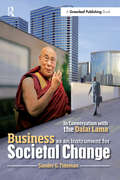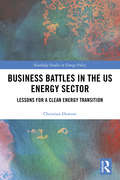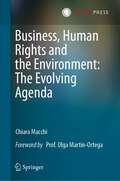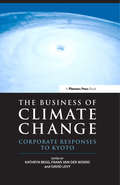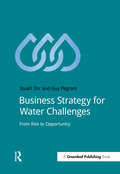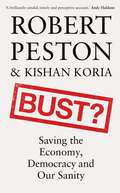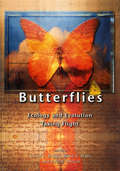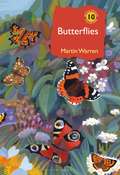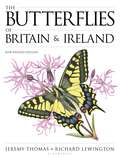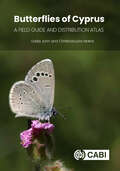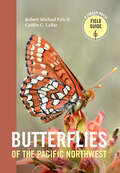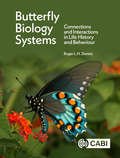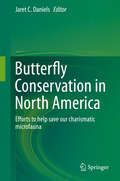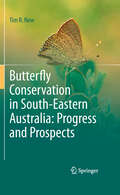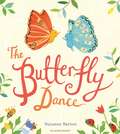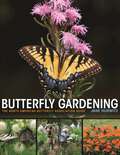- Table View
- List View
Business as an Instrument for Societal Change: In Conversation with the Dalai Lama
by Sander TidemanBusiness as an Instrument for Societal Change: In Conversation with the Dalai Lama is the result of two decades of research and dialogue with His Holiness the Dalai Lama and other leaders in business, government, science and education. Author Sander Tideman, a lawyer and banker who has maintained a friendship with the Dalai Lama over all these years, presents a practical framework and methodology to develop a new kind of leadership - one fit to repurpose the business world and tackle escalating social, economic and environmental needs. The Dalai Lama rarely speaks directly on the topics of business, leadership and economics. Yet in the dialogues recounted here, his wisdom - combined with key insights from business and public leaders -creates a unified shift towards a consciousness of interconnectedness, offering profound insights for practitioners and general readers alike. Tideman unites the scientific worldviews of physics, neuroscience and economics with the positive psychology of human relationships, and ancient spiritual wisdom, to formulate practical business leadership solutions. While recognizing the need for change in external structures and governance, Tideman highlights the importance of opening our minds, and connecting inner and outer spirituality. At the same time, he focuses on concrete practices for winning the hearts and minds of employees, customers, communities, and society at large, while addressing deep-rooted problems such as extreme social inequality and continued financial collapses. At the heart of this book lies the journey to discover our shared purpose. This ignites new sources of value creation for the organisation, customers and society, which Tideman terms 'triple value'. We can achieve triple value by aligning societal and business needs, based on the fundamental reality of interconnection. Business as an Instrument for Societal Change: In Conversation with the Dalai Lama is a readable and intelligent exploration of how leaders can actually help to shape a sustainable global economy by embracing innate human and humane behaviour. It is also Tideman's fascinating personal journey, which brought him to question the underlying motivations and goals of business leadership and to seek a new paradigm for a more sustainable approach. Reflecting Tideman's sharp perceptions and infused with the Dalai Lama's unmistakable joy, this book has the power to change your way of thinking.
Business Battles in the US Energy Sector: Lessons for a Clean Energy Transition (Routledge Studies in Energy Policy)
by Christian DownieThis book is ground breaking in its study of business actors in climate and energy politics. While various studies have demonstrated the influence of business actors across multiple policy domains, this is the first to examine the behaviour of business actors in energy centric industries in the US that will be vital for achieving a clean energy transition, namely the oil, gas, coal, utility, and renewable industries. Drawing on almost 80 interviews with senior energy executives, lobbyists, and policymakers, it asks two central questions: (i) how and why are business actors shaping energy policy contests in the US? And (ii) what are the implications for policymakers? In answering these questions, this book provides new insights about the preferences and strategies of business in the energy sector, and, significantly, it identifies strategies for policymakers seeking to regulate energy in the face of political resistance from incumbent fossil fuel industries. This book will be of particular value to students, scholars, and policymakers working in the fields of energy, climate, and environmental politics, as well as individuals generally interested in the role that business exerts over policy processes.
Business Battles in the US Energy Sector: Lessons for a Clean Energy Transition (Routledge Studies in Energy Policy)
by Christian DownieThis book is ground breaking in its study of business actors in climate and energy politics. While various studies have demonstrated the influence of business actors across multiple policy domains, this is the first to examine the behaviour of business actors in energy centric industries in the US that will be vital for achieving a clean energy transition, namely the oil, gas, coal, utility, and renewable industries. Drawing on almost 80 interviews with senior energy executives, lobbyists, and policymakers, it asks two central questions: (i) how and why are business actors shaping energy policy contests in the US? And (ii) what are the implications for policymakers? In answering these questions, this book provides new insights about the preferences and strategies of business in the energy sector, and, significantly, it identifies strategies for policymakers seeking to regulate energy in the face of political resistance from incumbent fossil fuel industries. This book will be of particular value to students, scholars, and policymakers working in the fields of energy, climate, and environmental politics, as well as individuals generally interested in the role that business exerts over policy processes.
Business, Human Rights and the Environment: The Evolving Agenda
by Chiara MacchiMore than ten years after the adoption of the UN Guiding Principles on Business and Human Rights, this book critically reviews the achievements, limits and next frontiers of business and human rights following the ‘protect, respect, remedy’ trichotomy. The UN Guiding Principles acted as a catalyst for hitherto unprecedented regulatory and judicial developments. The monograph by Macchi proposes a functionalist reading of the state’s duty to regulate the transnational activities of corporations in order to protect human rights and adopts a holistic approach to the corporate responsibility to respect, arguing that environmental and climate due diligence are inherent dimensions of human rights due diligence. In the volume emerging legislations are assessed on mandatory human rights and environmental due diligence, as well as the potential and limitations of a binding international treaty on business and human rights. The book also reviews groundbreaking litigation against transnational corporations, such as Lungowe v. Vedanta or Milieudefensie v. Shell, for their human rights and climate change impacts. The book is primarily targeted at academic and non-academic legal experts, as well as at researchers and students looking at business and human rights issues through the lenses of legal studies (particularly international law and European law), political sciences, business ethics, and management. Additionally, it should also find a readership among practitioners working in the public or private sector (consultants, CSR officers, legal officers, etc.) willing to familiarize themselves with the expanding areas of liability, financial and reputational risks connected to the social and environmental impacts of global supply chains.Chiara Macchi is currently Lecturer in Law at Wageningen University & Research in The Netherlands.
The Business of Climate Change: Corporate Responses to Kyoto
by Kathryn Begg FRANS VAN DER WOERD David LevyIn recent years climate change has become a leading issue on both the business and political agenda. With the Kyoto Protocol to the UN Framework Convention on Climate Change now ratified, business is bracing itself for the reality of serious regulation on the reduction of greenhouse gas emissions.The Business of Climate Change presents a state-of-the-art analysis of corporate responses to the climate change issue. The book describes and assesses a number of recent business approaches that will help to identify effective strategies and promote the dissemination of proactive corporate practices on climate change worldwide. By identifying the factors that cause companies to pursue low-carbon strategies and support the Kyoto process, the book will also be helpful to governments in formulating policy.Business and industry have a crucial role to play in the implementation of the Kyoto Protocol. They are major emitters of greenhouse gases, and pressure is mounting for them to engage in a range of mitigation strategies, from emission inventorying and trading schemes to investments in low-carbon technologies. Behind the scenes a number of companies have started to develop strategies to curtail greenhouse gas emissions.These strategies can be very diverse in nature. At a political level, companies try to influence policy implementation and, more specifically, to test ideas in anticipation of possible regulation on the climate change issue. At a more practical level, there are a burgeoning number of initiatives to conserve energy use in production, transportation and buildings, to develop renewable sources of energy, to measure carbon emissions and sequestration at a detailed level, and to develop various markets for trading carbon credits among companies and countries. Some technologies, such as hybrid cars and compact fluorescent lighting, are now market realities.Common to all of these initiatives is that they operate in an environment of high complexity and uncertainty. The political implementation of the Kyoto Protocol remains uncertain and many details remain unspecified. Economic instruments such as emission trading are favoured, but their mechanisms are still hotly debated and the future price of credits is unknown. New markets for low-emission products and technologies are beginning to appear, but there are currently few regulatory drivers to assist their development. The impact of potential regulation on business will vary tremendously between companies and sectors. The fossil fuel and energy sectors fear the economics of action, while sectors such as insurance and agriculture fear the economics of inaction. Combined with the remaining uncertainties about what form climate change may take, corporate responses to reduce risks have to differentiate between sectors and have to be flexible. For individual companies, these big uncertainties demand new thinking and contingency planning.The Business of Climate Change is split into four sections: "Introduction and overview" presents a broad perspective on business and climate policies
The Business of Climate Change: Corporate Responses to Kyoto
by Kathryn Begg Frans Van Der Woerd David LevyIn recent years climate change has become a leading issue on both the business and political agenda. With the Kyoto Protocol to the UN Framework Convention on Climate Change now ratified, business is bracing itself for the reality of serious regulation on the reduction of greenhouse gas emissions.The Business of Climate Change presents a state-of-the-art analysis of corporate responses to the climate change issue. The book describes and assesses a number of recent business approaches that will help to identify effective strategies and promote the dissemination of proactive corporate practices on climate change worldwide. By identifying the factors that cause companies to pursue low-carbon strategies and support the Kyoto process, the book will also be helpful to governments in formulating policy.Business and industry have a crucial role to play in the implementation of the Kyoto Protocol. They are major emitters of greenhouse gases, and pressure is mounting for them to engage in a range of mitigation strategies, from emission inventorying and trading schemes to investments in low-carbon technologies. Behind the scenes a number of companies have started to develop strategies to curtail greenhouse gas emissions.These strategies can be very diverse in nature. At a political level, companies try to influence policy implementation and, more specifically, to test ideas in anticipation of possible regulation on the climate change issue. At a more practical level, there are a burgeoning number of initiatives to conserve energy use in production, transportation and buildings, to develop renewable sources of energy, to measure carbon emissions and sequestration at a detailed level, and to develop various markets for trading carbon credits among companies and countries. Some technologies, such as hybrid cars and compact fluorescent lighting, are now market realities.Common to all of these initiatives is that they operate in an environment of high complexity and uncertainty. The political implementation of the Kyoto Protocol remains uncertain and many details remain unspecified. Economic instruments such as emission trading are favoured, but their mechanisms are still hotly debated and the future price of credits is unknown. New markets for low-emission products and technologies are beginning to appear, but there are currently few regulatory drivers to assist their development. The impact of potential regulation on business will vary tremendously between companies and sectors. The fossil fuel and energy sectors fear the economics of action, while sectors such as insurance and agriculture fear the economics of inaction. Combined with the remaining uncertainties about what form climate change may take, corporate responses to reduce risks have to differentiate between sectors and have to be flexible. For individual companies, these big uncertainties demand new thinking and contingency planning.The Business of Climate Change is split into four sections: "Introduction and overview" presents a broad perspective on business and climate policies
Business Power and Conflict in International Environmental Politics
by R. FalknerThis book puts forward a distinctive theoretical approach and analytical framework for studying business as an international actor in the environmental field, and provides detailed case studies of the most important environmental challenges in recent years.
Business Strategy for Water Challenges: From Risk to Opportunity
by Stuart Orr Guy PegramWater is a resource under increased stress, with its management now cited as one of the greatest risks to business continuity and growth. This concise guide for professionals offers strategic steps for developing a corporate water stewardship strategy. It will enable you to: define business water risks, and the opportunities associated with those risks; explore, through sector-specific profiles, risks associated with regulation, reputation, external response and engagement, and physical incidents; develop a clear plan and process for creating, managing and mainstreaming a corporate water strategy; identify several initiatives and new risk tools that your company can use to stay on top of best practice in water management. With the advent of risk tools, and a growing list of testaments around business risk from water, we are now able to respond more appropriately to how this resource is impacted by and impacts upon business. Use this book as your guide as you begin to build your company's strategy around water.
Business Strategy for Water Challenges: From Risk to Opportunity (Doshorts Ser.)
by Stuart Orr Guy PegramWater is a resource under increased stress, with its management now cited as one of the greatest risks to business continuity and growth. This concise guide for professionals offers strategic steps for developing a corporate water stewardship strategy. It will enable you to: define business water risks, and the opportunities associated with those risks; explore, through sector-specific profiles, risks associated with regulation, reputation, external response and engagement, and physical incidents; develop a clear plan and process for creating, managing and mainstreaming a corporate water strategy; identify several initiatives and new risk tools that your company can use to stay on top of best practice in water management. With the advent of risk tools, and a growing list of testaments around business risk from water, we are now able to respond more appropriately to how this resource is impacted by and impacts upon business. Use this book as your guide as you begin to build your company's strategy around water.
Bust?: Saving the Economy, Democracy and Our Sanity
by Robert Peston'A brilliantly candid, timely and perceptive account.' Andy Haldane'Asks all the right questions.' Mark CarneyHas the West gone bust - economically, politically and socially? Or is there another way?We in the West appear to be at a year zero, with the seeming end of the relative peace and prosperity we took for granted. The pandemic, Putin's invasion of Ukraine, growing tension with China, a rolling back of globalisation, Brexit, the return of inflation and painful interest rates - all these have shattered the illusions of the world as we knew it.For years our politicians have said they were going for growth and would ensure that those with least would benefit disproportionately from the proceeds of that growth. They've failed. Growth has vanished. The poorest are desperately struggling to heat their homes and to eat.We are at that point where confidence in our fundamental institutions has been undermined by leaders who have an uncomfortable relationship with the truth and by an economy that has mainly served the richest.How bad will it get? And how do we simultaneously rebuild prosperity, democracy and social cohesion? Can we have it all, or will we have to make very significant financial sacrifices in the coming years, knowingly and willingly, to restore that national sense of pride and solidarity of purpose?If the chaos of the last few years mark the end of the old order as we knew it, what will and should follow, to save our prosperity, our democracy and our sanity.It's time to abandon pessimism and fatalism and look for answers. Bust? doesn't have all of them. But it will start an important debate, about how to allow us all to hope again.
Butterflies: Ecology and Evolution Taking Flight
by Carol L. Boggs Ward B. Watt Paul R. EhrlichIn Butterflies: Ecology and Evolution Taking Flight, the world's leading experts synthesize current knowledge of butterflies to show how the study of these fascinating creatures as model systems can lead to deeper understanding of ecological and evolutionary patterns and processes in general. The twenty-six chapters are organized into broad functional areas, covering the uses of butterflies in the study of behavior, ecology, genetics and evolution, systematics, and conservation biology. Especially in the context of the current biodiversity crisis, this book shows how results found with butterflies can help us understand large, rapid changes in the world we share with them—for example, geographic distributions of some butterflies have begun to shift in response to global warming, giving early evidence of climate change that scientists, politicians, and citizens alike should heed. The first international synthesis of butterfly biology in two decades, Butterflies: Ecology and Evolution Taking Flight offers students, scientists, and amateur naturalists a concise overview of the latest developments in the field. Furthermore, it articulates an exciting new perspective of the whole group of approximately 15,000 species of butterflies as a comprehensive model system for all the sciences concerned with biodiversity and its preservation. Contributors: Carol L. Boggs, Paul M. Brakefield, Adriana D. Briscoe, Dana L. Campbell, Elizabeth E. Crone, Mark Deering, Henri Descimon, Erika I. Deinert, Paul R. Ehrlich, John P. Fay, Richard ffrench-Constant, Sherri Fownes, Lawrence E. Gilbert, André Gilles, Ilkka Hanski, Jane K. Hill, Brian Huntley, Niklas Janz, Greg Kareofelas, Nusha Keyghobadi, P. Bernhard Koch, Claire Kremen, David C. Lees, Jean-François Martin, Antónia Monteiro, Paulo César Motta, Camille Parmesan, William D. Patterson, Naomi E. Pierce, Robert A. Raguso, Charles Lee Remington, Jens Roland, Ronald L. Rutowski, Cheryl B. Schultz, J. Mark Scriber, Arthur M. Shapiro, Michael C. Singer, Felix Sperling, Curtis Strobeck, Aram Stump, Chris D. Thomas, Richard VanBuskirk, Hans Van Dyck, Richard I. Vane-Wright, Ward B. Watt, Christer Wiklund, and Mark A. Willis
Butterflies: Ecology and Evolution Taking Flight
by Carol L. Boggs Ward B. Watt Paul R. EhrlichIn Butterflies: Ecology and Evolution Taking Flight, the world's leading experts synthesize current knowledge of butterflies to show how the study of these fascinating creatures as model systems can lead to deeper understanding of ecological and evolutionary patterns and processes in general. The twenty-six chapters are organized into broad functional areas, covering the uses of butterflies in the study of behavior, ecology, genetics and evolution, systematics, and conservation biology. Especially in the context of the current biodiversity crisis, this book shows how results found with butterflies can help us understand large, rapid changes in the world we share with them—for example, geographic distributions of some butterflies have begun to shift in response to global warming, giving early evidence of climate change that scientists, politicians, and citizens alike should heed. The first international synthesis of butterfly biology in two decades, Butterflies: Ecology and Evolution Taking Flight offers students, scientists, and amateur naturalists a concise overview of the latest developments in the field. Furthermore, it articulates an exciting new perspective of the whole group of approximately 15,000 species of butterflies as a comprehensive model system for all the sciences concerned with biodiversity and its preservation. Contributors: Carol L. Boggs, Paul M. Brakefield, Adriana D. Briscoe, Dana L. Campbell, Elizabeth E. Crone, Mark Deering, Henri Descimon, Erika I. Deinert, Paul R. Ehrlich, John P. Fay, Richard ffrench-Constant, Sherri Fownes, Lawrence E. Gilbert, André Gilles, Ilkka Hanski, Jane K. Hill, Brian Huntley, Niklas Janz, Greg Kareofelas, Nusha Keyghobadi, P. Bernhard Koch, Claire Kremen, David C. Lees, Jean-François Martin, Antónia Monteiro, Paulo César Motta, Camille Parmesan, William D. Patterson, Naomi E. Pierce, Robert A. Raguso, Charles Lee Remington, Jens Roland, Ronald L. Rutowski, Cheryl B. Schultz, J. Mark Scriber, Arthur M. Shapiro, Michael C. Singer, Felix Sperling, Curtis Strobeck, Aram Stump, Chris D. Thomas, Richard VanBuskirk, Hans Van Dyck, Richard I. Vane-Wright, Ward B. Watt, Christer Wiklund, and Mark A. Willis
Butterflies: A Natural History (British Wildlife Collection)
by Martin WarrenThis new addition to the British Wildlife Collection is a unique take on butterfly behaviour and ecology, written by the former Chief Executive of Butterfly Conservation, Martin Warren. It explores the secret lives of our British species (also drawing on comparative examples from continental Europe), revealing how they have become adapted to survive in such a highly competitive natural world. Combining personal anecdote with the latest discoveries in the scientific literature, this book covers everything from why we love butterflies and their life-cycle from egg to adult, to their struggle for survival in a world of predators and parasites and the miracle of migration. The final chapters explore how butterflies are recorded, the change in their ranges and abundance during the 20th and 21st centuries, and the significance of managing habitats at a landscape scale, concluding with a passionate plea for why we must act now to reverse butterfly declines.Insightful, inspiring and a joy to read, Butterflies is the culmination of a lifetime of careful research into what makes these beautiful insects tick and how and why we must conserve them.
Butterflies: A Natural History (British Wildlife Collection)
by Martin WarrenThis new addition to the British Wildlife Collection is a unique take on butterfly behaviour and ecology, written by the former Chief Executive of Butterfly Conservation, Martin Warren. It explores the secret lives of our British species (also drawing on comparative examples from continental Europe), revealing how they have become adapted to survive in such a highly competitive natural world. Combining personal anecdote with the latest discoveries in the scientific literature, this book covers everything from why we love butterflies and their life-cycle from egg to adult, to their struggle for survival in a world of predators and parasites and the miracle of migration. The final chapters explore how butterflies are recorded, the change in their ranges and abundance during the 20th and 21st centuries, and the significance of managing habitats at a landscape scale, concluding with a passionate plea for why we must act now to reverse butterfly declines.Insightful, inspiring and a joy to read, Butterflies is the culmination of a lifetime of careful research into what makes these beautiful insects tick and how and why we must conserve them.
Butterflies: Ecology and Evolution Taking Flight
In Butterflies: Ecology and Evolution Taking Flight, the world's leading experts synthesize current knowledge of butterflies to show how the study of these fascinating creatures as model systems can lead to deeper understanding of ecological and evolutionary patterns and processes in general. The twenty-six chapters are organized into broad functional areas, covering the uses of butterflies in the study of behavior, ecology, genetics and evolution, systematics, and conservation biology. Especially in the context of the current biodiversity crisis, this book shows how results found with butterflies can help us understand large, rapid changes in the world we share with them—for example, geographic distributions of some butterflies have begun to shift in response to global warming, giving early evidence of climate change that scientists, politicians, and citizens alike should heed. The first international synthesis of butterfly biology in two decades, Butterflies: Ecology and Evolution Taking Flight offers students, scientists, and amateur naturalists a concise overview of the latest developments in the field. Furthermore, it articulates an exciting new perspective of the whole group of approximately 15,000 species of butterflies as a comprehensive model system for all the sciences concerned with biodiversity and its preservation. Contributors: Carol L. Boggs, Paul M. Brakefield, Adriana D. Briscoe, Dana L. Campbell, Elizabeth E. Crone, Mark Deering, Henri Descimon, Erika I. Deinert, Paul R. Ehrlich, John P. Fay, Richard ffrench-Constant, Sherri Fownes, Lawrence E. Gilbert, André Gilles, Ilkka Hanski, Jane K. Hill, Brian Huntley, Niklas Janz, Greg Kareofelas, Nusha Keyghobadi, P. Bernhard Koch, Claire Kremen, David C. Lees, Jean-François Martin, Antónia Monteiro, Paulo César Motta, Camille Parmesan, William D. Patterson, Naomi E. Pierce, Robert A. Raguso, Charles Lee Remington, Jens Roland, Ronald L. Rutowski, Cheryl B. Schultz, J. Mark Scriber, Arthur M. Shapiro, Michael C. Singer, Felix Sperling, Curtis Strobeck, Aram Stump, Chris D. Thomas, Richard VanBuskirk, Hans Van Dyck, Richard I. Vane-Wright, Ward B. Watt, Christer Wiklund, and Mark A. Willis
Butterflies of Britain and Ireland
by Jeremy ThomasThe Butterflies of Britain & Ireland provides comprehensive coverage of all our resident and migratory butterflies, including the latest information on newly discovered species such as Cryptic Wood White and the Geranium Bronze. When first published in 1991 it won the Natural World Book of the Year Award and won plaudits from all quarters. Fully revised, considerably expanded and reset in 2010, it was judged that year's Guardian Nature Book of the Year. Now revised again to reflect the latest research findings, and with up-to-date distribution maps, this remarkable book is THE guide to the appearance, behaviour, life cycle and ecology of the butterflies of Britain and Ireland.
The Butterflies of Britain and Ireland
by Jeremy ThomasThe Butterflies of Britain & Ireland provides comprehensive coverage of all our resident and migratory butterflies, including the latest information on newly discovered species such as Cryptic Wood White and the Geranium Bronze. When first published in 1991 it won the Natural World Book of the Year Award and won plaudits from all quarters. Fully revised, considerably expanded and reset in 2010, it was judged that year's Guardian Nature Book of the Year. Now revised again to reflect the latest research findings, and with up-to-date distribution maps, this remarkable book is THE guide to the appearance, behaviour, life cycle and ecology of the butterflies of Britain and Ireland.
Butterflies of Cyprus: A Field Guide and Distribution Atlas
by Eddie John Christodoulos MakrisThis new book summarises decades of research and collation of distributional data. From the tiny Freyeria trochylus (Grass Jewel), Europe's smallest butterfly, to the magnificent, newly arrived Papilio demoleus (Lime Swallowtail), this comprehensively illustrated reference book and field guide includes all butterfly species known in Cyprus over the past 100 years. Where applicable, reference is made to subspecies of related taxa present in nearby countries of the eastern Mediterranean. The images on the cover represent the island's seven endemics, discussed in depth. Included, too, are detailed distribution maps representing records garnered from almost 300 recorders/sources (particularly members of the Cyprus Butterfly Study Group), over a period of more than 20 years.
Butterflies of the Pacific Northwest (A Timber Press Field Guide)
by Robert Michael Pyle Caitlin C. LaBarA comprehensive guide to the butterflies of the Pacific Northwest from the region&’s foremost butterfly experts.
Butterfly Biology Systems: Connections and Interactions in Life History and Behaviour
by Roger L DennisIn Butterfly Biology Systems Roger Dennis explores key topics and contentious issues in butterfly biology, specifically those in life history and behaviour. Uniquely, using a systems approach, the book focuses on the degree of integration and feedback between components and elements affecting each issue, as well as the links between different issues. The book comprises four sections. The first two sections introduce the reader to principles and approaches for investigating complex relationships, and provide a platform of knowledge on butterfly biology. The final two sections deal in turn with life history and behaviour, covering key issues affecting different stages of development from eggs to adults. The book is extensively illustrated with original diagrams and models, all of which have detailed legends, produced to enhance a broader understanding, and to provide templates for future research. It includes a detailed bibliography and glossary providing an essential gateway to the extensive literature on butterfly biology. Butterfly Biology Systems is essential reading for graduate students and researchers in insect ecology, evolution, behaviour and conservation. It will also be of great value to anyone interested in butterflies. Introduces a systems approach to butterfly biology Includes succinct reviews of the key interrelationships in butterfly life history and behaviour Illustrates more than 100 models to advance research into butterfly biology systems
Butterfly Conservation in North America: Efforts to help save our charismatic microfauna
by Jaret C. DanielsThe book addresses this critical need by providing a straightforward and easy to read primer to key elements of at-risk butterfly conservation programs including captive husbandry, organism reintroduction, habitat restoration, population monitoring, recovery planning and cooperative programs.Impacts from habitat loss and fragmentation, invasive species, and climate change continue to accelerate the rate of imperilment and necessitate increased conservation action.Zoos, natural history museums, botanical gardens and wildlife agencies are progressively focusing on insects, particularly charismatic groups such as butterflies and native pollinators, to help advance local conservation efforts and foster increased community interest and engagement.Today, many institutions and their partners have successfully initiated at-risk butterfly conservation programs, and numerous others are exploring ways to become involved. However, insufficient experience and familiarity with insects is a critical constraint preventing staff and institutions from adequately planning, implementing and evaluating organism-targeted activities.The information provided is intended to improve staff practices, learn from existing programs, promote broader information exchange, and strengthen institutional ability to develop new or improve existing butterfly conservation initiatives.The information provided is intended to improve staff practices, learn from existing programs, promote broader information exchange, and strengthen institutional ability to develop new or improve existing butterfly conservation initiatives.This book will be useful to professionals from zoos, natural history museums, botanical gardens, wildlife agencies, conservation organizations, land managers, students, and scientist in conservation biology, ecology, entomology, biology, and zoology.
Butterfly Conservation in South-Eastern Australia: Progress and Prospects
by Tim R. NewA survey of the development and practice of butterfly conservation in south east Australia, tracing evolution of the science through a series of cases from focus on single subspecies through increasing levels of ecological complexity to critical biotopes and communities. The book summarises much previously scattered information, and provides access to much regional information of considerable interest to practitioners elsewhere.
The Butterfly Cove Collection (Butterfly Cove)
by Sarah Bennett‘Guaranteed to melt your heart!’ Rae Reads A perfectly enchanting collection of all three books in the heartwarming Butterfly Cove series! A year of taking chances…
The Butterfly Dance
by Suzanne BartonCaterpillars Dotty and Stripe do everything together. They play, they eat leaves and do all sorts of caterpiller-y things, and then one day, after spinning themselves into snuggly cocoons, they wake up as beautiful butterflies! But soon they realise that, for the first time ever, they look different. Should Dotty only play with butterflies that look like her? And Stripe only play with butterflies that look like him? A stunningly illustrated story about friendship and and being happy with who you are, from the author/illustrator of Waterstones Children's Book Prize shortlisted The Dawn Chorus.
Butterfly Gardening: The North American Butterfly Association Guide
by Jane HurwitzAn indispensable and lavishly illustrated guide to creating a garden that attracts and sustains butterfliesButterfly gardening creates habitats that support butterflies, connecting us with some of the most beautiful creatures in the natural world and bringing new levels of excitement and joy to gardening. In this engaging and accessible guide, lavishly illustrated with more than two hundred color photographs and maps, accomplished butterfly gardener Jane Hurwitz presents essential information on how to choose and cultivate plants that will attract a range of butterflies to your garden and help sustain all the stages of their life cycles. An indispensable resource for aspiring and experienced butterfly gardeners alike, Butterfly Gardening is the most gardener-friendly source on the subject, covering all the practical details needed to create a vibrant garden habitat that fosters butterflies. It tells you which plants support which butterflies, depending on where you live; it describes what different butterflies require in the garden over the course of their lives; and it shows you how to become a butterfly watcher as well as a butterfly gardener.While predominantly recommending regionally native plants, the book includes information on non-native plants. It also features informative interviews with experienced butterfly gardeners from across the United States. These gardeners share a wealth of information on plants and practices to draw butterflies to all kinds of gardens--from small suburban gardens to community plots and larger expanses.Whether you are a gardener who wants to see more butterflies in your garden, a butterfly enthusiast who wants to bring that passion to the garden, or someone who simply wants to make their garden or yard friendlier to Monarchs or other butterflies, this is a must-have guide.An essential guide for aspiring and experienced butterfly gardenersEncourages readers to rethink gardening choices to support butterflies and other pollinators in their gardens and communitiesIntroduces gardeners to butterfly watchingIncludes regional lists of plant species that are time-proven to help sustain butterflies and their caterpillarsFeatures informative interviews with expert butterfly gardeners from across the United States
